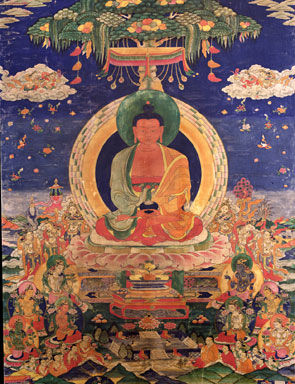"Buddha in Paradise" au Rubin Museum of Art, NY
Yogambara, Tibet, 17th century. Pigment on Cloth 38 1/2 x 25 1/2 in. Rubin Museum of Art, C2001.1.2 (HAR 65002)
NEW YORK.- Rubin Museum of Art (RMA) presents Buddha in Paradise, an exhibition of more than 40 works of painting, sculpture, and ritual texts, drawn from the museum’s permanent collection, which explores the concept of paradise in Tibetan Buddhism. The works of art range in date from the 13th to early 20th century but illustrate ideas and beliefs that have endured for thousands of years.
Human beings across cultures have long envisioned realms beyond the hardship of ordinary existence. Most cultures have created descriptions – oral, visual, written -of such realms or states of being. In Tibetan Buddhism, paradise is conceptualized as multiple perfect realms called “Pure Lands,” which are apart from the world we know and are where enlightenment can be quickly attained. Rather than a monolithic understanding of paradise, Tibetan Buddhism contains different approaches and teachings about these lands and how to reach them, the most radical of which confronts us with the realization that paradise is all around us if we are able to perceive it.
Buddha in Paradise is organized into sections that examine the different Pure Lands well known and aspired to by Tibetan Buddhists and the underlying philosophical beliefs by which they are defined. Topics explored include the endless cycle of death and rebirth and paths out of its hold; the fundamental Buddhist idea that there are two levels of reality; the life of the historical Buddha
Shakyamuni and the Pure Lands surrounding the other important deities in the Tibetan Buddhist pantheon; and particular Pure Lands that are among the most prominent in Tibetan Buddhist teachings and popular among Tibetan people.
Among the works of art on view is a late 19th-century Tibetan painting depicting the “Wheel of Becoming.” It illustrates, in great detail, the Buddhist conception of the cycle of birth and death and, depending on the conduct of one’s life, the possibilities for rebirth. Also included in the exhibition is a richly colored 19th-century Tibetan painting of Buddha Amitabha, seated in the Pure Land he inhabits called “Sukhavati.” Across Buddhist Asia, Sukhavati is the most popular Pure Land because it is the easiest to reach and holds abundant, perfect pleasures that facilitate enlightenment.Taken as a whole, the visions of paradise gathered together and examined in Buddha in Paradise show how the universal human awareness and understanding of the temporality of life and the struggle of living manifests itself in Tibetan Buddhism.
Amitabha Buddha, Central Tibet, 19th century. Pigments on cloth 38 1/2 x 25 1/2 in. Rubin Museum of Art, F1997.6.3 (HAR 85)

/https%3A%2F%2Fprofilepics.canalblog.com%2Fprofilepics%2F1%2F0%2F100183.jpg)
/https%3A%2F%2Fstorage.canalblog.com%2F03%2F02%2F119589%2F96711876_o.jpg)
/https%3A%2F%2Fstorage.canalblog.com%2F11%2F31%2F119589%2F94773502_o.jpg)
/https%3A%2F%2Fstorage.canalblog.com%2F20%2F83%2F119589%2F94772815_o.jpg)
/https%3A%2F%2Fstorage.canalblog.com%2F26%2F72%2F119589%2F75604929_o.jpg)
/https%3A%2F%2Fstorage.canalblog.com%2F59%2F60%2F119589%2F26458628_o.jpg)




/image%2F1371349%2F20240423%2Fob_b2fe42_telechargement-9.jpg)
/image%2F1371349%2F20240423%2Fob_af8bb4_telechargement-6.jpg)
/image%2F1371349%2F20240423%2Fob_b6c4a6_telechargement.jpg)
/image%2F1371349%2F20240423%2Fob_981d5f_h22891-l367411650-original.jpg)